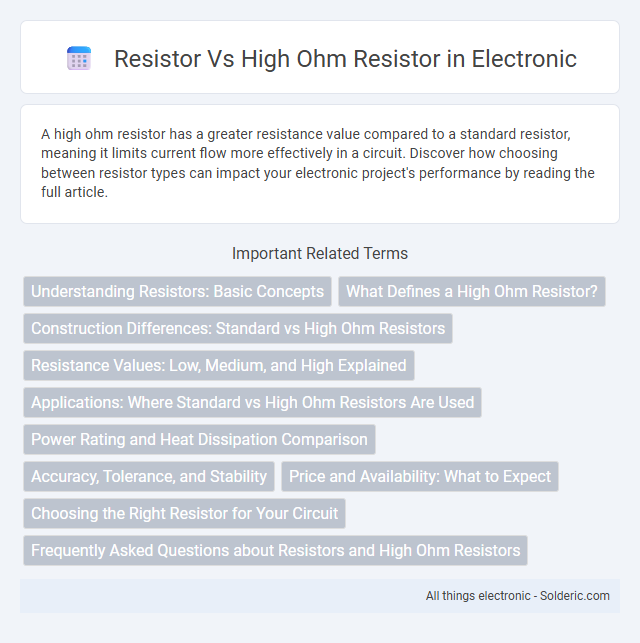A high ohm resistor has a greater resistance value compared to a standard resistor, meaning it limits current flow more effectively in a circuit. Discover how choosing between resistor types can impact your electronic project's performance by reading the full article.
Comparison Table
| Feature | Resistor | High Ohm Resistor |
|---|---|---|
| Resistance Range | Ohms to megaohms (typically 1O to 10MO) | High resistance values, usually above 10MO up to GO range |
| Common Applications | Current limiting, voltage division, signal conditioning | Leakage current reduction, high-voltage circuits, precision measurement |
| Power Rating | Ranges from 0.125W to several watts | Generally lower wattage, around 0.1W to 0.5W due to high resistance |
| Physical Size | Varies from small SMD to larger axial leaded resistors | Often similar or slightly larger due to insulation and design |
| Noise Level | Low to moderate noise depending on type | Higher noise sensitivity because of high resistance value |
| Cost | Generally low cost | Higher cost due to specialized materials and precision |
Understanding Resistors: Basic Concepts
Resistors regulate electrical current by providing resistance measured in ohms, with standard resistors typically ranging from 1 ohm to 1 megaohm. High ohm resistors, often exceeding 1 megaohm, limit current more significantly, making them ideal for sensitive circuits and voltage division tasks. Understanding the resistance value that suits your application ensures optimal performance and prevents circuit damage.
What Defines a High Ohm Resistor?
A high ohm resistor is defined by its resistance value, typically ranging from megaohms (MO) to gigaohms (GO), which is significantly higher than standard resistors measured in kiloohms (kO) or ohms (O). This elevated resistance limits current flow to extremely low levels, making high ohm resistors essential for applications requiring precise control of small currents or voltage division in sensitive circuits. Their construction often involves specialized materials and techniques to maintain stability and minimize noise at such high resistance values.
Construction Differences: Standard vs High Ohm Resistors
Standard resistors typically feature carbon film or metal film construction designed for low to moderate resistance values, whereas high ohm resistors employ specialized materials like metal oxide or wire-wound with high resistivity alloys to achieve greater resistance levels. The geometry of high ohm resistors often incorporates longer, thinner resistive elements or multiple winding layers to increase resistance without sacrificing stability. Material composition and precise manufacturing processes ensure high ohm resistors maintain accuracy and reliability under high voltage and temperature conditions compared to standard resistors.
Resistance Values: Low, Medium, and High Explained
Resistors are electrical components that limit current flow, categorized by their resistance values: low (under 100 ohms), medium (100 ohms to 1 megaohm), and high (above 1 megaohm). Low-value resistors are commonly used for current limiting and signal attenuation, while medium-value resistors serve in voltage division and biasing circuits. High-ohm resistors provide significant resistance, ideal for applications requiring minimal current flow or high-impedance circuits, such as sensor inputs and voltage measuring devices.
Applications: Where Standard vs High Ohm Resistors Are Used
Standard resistors are commonly used in general electronic circuits for current limiting, voltage division, and biasing components, making them essential in everyday devices like radios, televisions, and computers. High ohm resistors, with their significantly larger resistance values, are crucial in specialized applications such as sensitive measurement instruments, high impedance amplifiers, and precision voltage sensing, where minimal current flow and high stability are required. Understanding the differences helps you select the right resistor type for your circuit's performance and accuracy needs.
Power Rating and Heat Dissipation Comparison
High ohm resistors typically have higher resistance values, resulting in lower current flow and reduced power dissipation compared to standard resistors of the same power rating. Power rating indicates the maximum wattage a resistor can safely dissipate without damage, with high ohm resistors often designed for lower power applications due to their inherent heat generation limitations. Effective heat dissipation in resistors depends on their material, size, and construction, where high ohm resistors may require additional cooling methods or specialized packaging to maintain thermal stability under load.
Accuracy, Tolerance, and Stability
High ohm resistors typically offer greater accuracy and tighter tolerance levels compared to standard resistors, making them ideal for precision circuits. Their stability over temperature changes and time is superior due to specialized materials and construction, reducing drift and ensuring consistent performance. Your choice of resistor impacts the reliability of sensitive electronic measurements, where stability and precise resistance values are critical.
Price and Availability: What to Expect
High ohm resistors typically cost more than standard resistors due to their specialized materials and manufacturing processes that ensure higher resistance values and precision. Availability of high ohm resistors can be limited compared to low or medium ohm resistors, as they are less commonly used in everyday electronics, often requiring orders from specialized suppliers or distributors. Bulk pricing for standard resistors is generally more favorable, making them more accessible for large-scale production and hobbyist projects.
Choosing the Right Resistor for Your Circuit
Choosing the right resistor for your circuit depends on the specific resistance value and power rating needed to ensure optimal performance. High ohm resistors, often exceeding 1 MO, are ideal for applications requiring minimal current flow, such as signal processing and sensor circuits. Your selection should balance resistance, tolerance, and power dissipation to achieve accurate voltage control and protection in electronic designs.
Frequently Asked Questions about Resistors and High Ohm Resistors
Resistors regulate electrical current by providing specific resistance values measured in ohms, with high ohm resistors offering significantly greater resistance to limit current flow in sensitive circuits. Common questions address differences in applications, where high ohm resistors are essential for precision tasks like voltage division and signal conditioning, while standard resistors suit general current control. Understanding tolerance, power rating, and noise characteristics helps clarify their distinct roles in electronic designs.
resistor vs high ohm resistor Infographic

 solderic.com
solderic.com